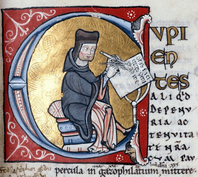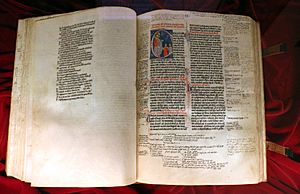Peter Lombard facts for kids
Quick facts for kids
Peter Lombard
|
|
|---|---|

Peter Lombard at work
|
|
| Born | 1096 |
| Died | July 21/22, 1160 |
| Alma mater | School of Reims University of Bologna |
| Occupation | Bishop of Paris |
|
Notable work
|
|
| Title | Master of the Sentences |
| Scientific career | |
| Influences |
|
| Influenced | |
Peter Lombard (also known as Peter the Lombard or Petrus Lombardus) was born around 1096 in Novara, Italy. He passed away on July 21 or 22, 1160, in Paris, France.
Peter Lombard was a very important theologian and a Bishop of Paris. He wrote a famous book called Four Books of Sentences. This book became the main textbook for studying theology for many centuries. Because of this, he was known as Magister Sententiarum, which means "Master of the Sentences".
Contents
Biography
Early life and education
Peter Lombard was born in Lumellogno, a small town near Novara, in northwestern Italy. His family was not wealthy. He was likely born between the years 1095 and 1100.
He probably started his education in Italy. He attended cathedral schools in Novara and Lucca. A bishop named Odo of Lucca helped him. Odo recommended Peter to Bernard of Clairvaux, a very influential person at the time.
This support allowed Peter to travel to Reims and Paris in France to continue his studies. He first studied at the cathedral school in Reims. Around 1134, he arrived in Paris.
Becoming a professor
In Paris, Peter Lombard taught at the famous cathedral school of Notre Dame. He spent about ten years there. During this time, he met other leading thinkers like Peter Abelard and Hugh of St. Victor.
By 1142, Peter was recognized as a skilled teacher and writer. Around 1145, he became a "magister," which means a professor, at Notre Dame. It is believed that the canons (priests) of Notre Dame invited him to join them because of his excellent teaching skills.
Peter Lombard did not have powerful family connections or political friends in France. He was chosen purely for his academic talent. By 1144, he was already considered a "celebrated theologian."
Priesthood and Bishop of Paris
Peter Lombard became a subdeacon in 1147. He attended an important meeting called the Council of Rheims in 1148. This meeting was led by Pope Eugene III. Peter was among those who signed a document condemning certain teachings at the council.
After 1150, he became a deacon and then an archdeacon. He was ordained as a priest before 1156. On July 28, 1159, Peter Lombard became the bishop of Paris.
His time as bishop was short. Peter Lombard died on July 21 or 22, 1160. He was replaced by Maurice de Sully, who was famous for building the Cathedral of Notre Dame. Peter Lombard's tomb was destroyed during the French Revolution.
Writings
Peter Lombard wrote comments on the Psalms and the letters of Paul. But his most famous work was Libri Quatuor Sententiarum, or the Four Books of Sentences. This book became the main textbook for theology in medieval universities.
From the 1220s until the 1500s, no other Christian book, except the Bible, was studied and commented on more often. Many great thinkers, like Albert the Great and Thomas Aquinas, were influenced by it. Even Martin Luther and John Calvin, who were important figures in the Reformation, studied and quoted from it.
The Four Books of Sentences was not a debate itself. Instead, it was a collection of texts from the Bible. It also included important writings from early Christian leaders, known as Church Fathers, and other medieval thinkers. It covered almost all Christian theology known at that time.
Peter Lombard's book was the first major effort to bring together comments on many theological topics. He arranged the material in a clear, organized way. He also tried to explain how different viewpoints could be understood together.
The Sentences is divided into four books:
- Book I talks about the Trinity (God as Father, Son, and Holy Spirit).
- Book II discusses creation.
- Book III focuses on Christ, the savior.
- Book IV deals with the sacraments, which are special religious ceremonies.
Main ideas
Peter Lombard had some important and sometimes debated ideas in his Sentences.
One famous idea was in Book I. He suggested that when Christians truly love God and their neighbors, this love is actually the Holy Spirit itself. This means that through love, a person becomes closer to God. While this idea was never officially called wrong, not many theologians fully agreed with it.
Another important idea in the Sentences was about marriage. Peter Lombard believed that marriage was based on the agreement between two people. He thought that a marriage was complete even if the couple did not have children. This was different from some other views at the time. His idea was later supported by Pope Alexander III. This had a big impact on how the Church understood marriage.
Works
- Magna glossatura
- Sentences. Book 1: The Mystery of the Trinity. Translated by Giulio Silano. Toronto, Pontifical Institute of Mediaeval Studies (PIMS), 2007.
- Sentences. Book 2: On Creation. Translated by Giulio Silano. Toronto, PIMS, 2008.
- Sentences. Book 3: On the Incarnation of the Word. Translated by Giulio Silano. Toronto, PIMS, 2008.
- Sentences. Book 4: The Doctrine of Signs. Translated by Giulio Silano. Toronto, PIMS, 2010.
See also
 In Spanish: Pedro Lombardo para niños
In Spanish: Pedro Lombardo para niños


